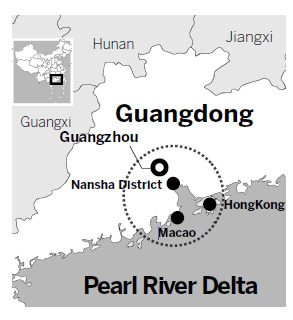A bigger picture for Guangzhou's Nansha
Updated: 2012-05-09 07:23
By Kang Bing and Li Wenfang in Guangzhou (China Daily)
|
|||||||||||
Former 'Siberia' of Guangzhou is place with 'immense' potential
Once dubbed "the Siberia" of Guangzhou, Nansha district remains a surprise to visitors. With its patches of subtropical farmland, interconnecting rivers and blue sky, it stands in contrast to the densely populated manufacturing towns found in other parts of the Pearl River Delta.
The district, as large as Singapore and located in the center of the delta, has stood rather silently for the past three decades while the region around it was transformed into the export-oriented manufacturing hub of the world.
But now, the southeastern tip of Guangzhou, Guangdong province, is due to have its day.
In the national Five-Year Plan (2011-15), Nansha was designated as a business service center for the Chinese mainland, linking it to the Hong Kong and Macao special administrative regions. The district will also serve as a technological innovation center, an educational and training base and an area for cooperation in services related to portside industries.
Back in 2010, the Guangdong provincial government assigned it the role of a pilot in implementing the Closer Economic Partnership Arrangement, a free trade pact between the mainland and the two special administrative regions.

In 2009, it was given the mission of becoming a platform for cooperation with the two regions in services and high-tech industry as written down in the Outline of the Plan for the Reform and Development of the Pearl River Delta, issued by the State Council.
The State Council is scrutinizing the development plan for the Nansha New Area, drafted by the provincial and city governments, said Huang Ka, deputy head of Nansha.
"We look forward to having it approved by the State Council later this year," Huang said.
The district will take a pilot approach to developing a quality living space for people in Guangdong, Hong Kong and Macao and an international business environment. It will explore a new mode of urbanization in order to become a leading place in science, education and innovation, as well as a service hub in South China, Huang said.
Nansha was not ignored by the government or investors, but its strategic role had to evolve.
In the latter part of the 1990s, the late Hong Kong tycoon Henry Fok Ying-tung started to invest in infrastructure in Nansha. He and his family poured billions of yuan into roads, bridges, a ferry terminal, a school, research facilities and real estate developments.
Nansha received the go-ahead to build a national economic and technological zone in 1993.
Plans to build a base for a mammoth oil refinery and iron and steel complexes there were later relocated to Zhanjiang city, Guangdong, mainly for ecological reasons.
Nansha has an excellent location and deep-water port, a sound ecological system and proximity to both Hong Kong and Macao by sea, said Peng Peng, a senior researcher with the Guangzhou Academy of Social Sciences.
Nansha lies in the center of a 100-kilometer radius covering all of the delta cities and the two special administrative regions. It takes only 75 minutes to travel to downtown Hong Kong by ferry.
Although Nansha lags behind Shanghai Pudong New Area and Tianjin Binhai New Area in terms of development speed, it has huge potential and there is "great room for imagination", he said.
Compared with Hengqin New Area in Zhuhai and Qianhai New Area in Shenzhen - which are planned as key areas for cooperation with Macao and Hong Kong, respectively - Nansha has a bigger role to play, linking the special administrative regions.
With more land and a longer coastline, Nansha is capable of housing a greater variety of industries.
As Hong Kong investors move forward from the export-oriented pattern of having the store in Hong Kong and the factory in the delta, they are increasingly drawn to the service industry, said Ronald Ho, regional director for South China, Hong Kong Development Council.
They have become more confident in investing in less developed areas, such as Nansha. Ho describes Nansha's potential as "immense".
Nansha could become a conveniently accessible green area for people in crowded cities to visit, a place where they could breathe the air and enjoy their holidays, he said.
More than 300 investment projects have been introduced to Nansha in the past decade, involving 26 of the world's top 500 firms, Huang said. They include GAC Toyota Motor Co, Dongfang Electric (Guangzhou) Heavy Machinery Co and CSSC Guangzhou Longxue Shipbuilding Co.
On the science and innovation front, the Hong Kong University of Science and Technology Fok Ying-tung Graduate School, the Guangzhou Institute of Industry Technology of the Chinese Academy of Sciences and the Modern Industry Technology Institute of the Ministry of Education are located in Nansha.
The GDP of Nansha grew by on average 27.3 percent annually between 2005 and 2011, and the industrial output by 37.5 percent every year during the period, Huang said.
The wetland park, where migrant birds spend the winter, and the farmers' market, located where the Pearl River runs into the sea, are attracting tourists.
An improved transport network, better business and residential services and continued protection of the environment hold the key to Nansha's future.
The government is taking an unhurried approach to the development of Nansha.
"It's like painting on a blank sheet of paper. You don't want to ruin the picture with reckless brush strokes," Huang said.
Contact the writers at kangbing@chinadaily.com.cn and liwenfang@chinadaily.com.cn
Today's Top News
President Xi confident in recovery from quake
H7N9 update: 104 cases, 21 deaths
Telecom workers restore links
Coal mine blast kills 18 in Jilin
Intl scholarship puts China on the map
More bird flu patients discharged
Gold loses sheen, but still a safe bet
US 'turns blind eye to human rights'
Hot Topics
Lunar probe , China growth forecasts, Emission rules get tougher, China seen through 'colored lens', International board,
Editor's Picks

|

|

|

|

|

|





